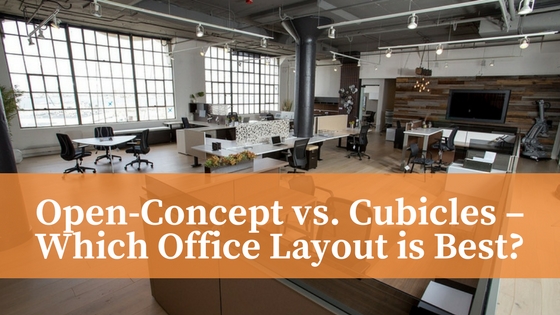 There’s been much debate lately on the pros and cons of open concept office space versus the traditional cubicle-based layout of yesteryear. Both bring interesting advantages and disadvantages to the table, related to productivity, privacy, feeling of community, and workplace stress levels.
As modern office design continues to evolve, business owners, staff and construction companies are working together more than ever to customize a unique space tailored to the specific gifts of each individual office setting. At Fuhrmann Construction, we’re dedicated to continuing to research and investigate new and innovative office aesthetics and layouts so we can continually offer an up-to-date opinion of where the market is headed architecturally.
In this post we’ll pick apart open concept office space and cubicles and cross-compare what each of them bring to the table:
There’s been much debate lately on the pros and cons of open concept office space versus the traditional cubicle-based layout of yesteryear. Both bring interesting advantages and disadvantages to the table, related to productivity, privacy, feeling of community, and workplace stress levels.
As modern office design continues to evolve, business owners, staff and construction companies are working together more than ever to customize a unique space tailored to the specific gifts of each individual office setting. At Fuhrmann Construction, we’re dedicated to continuing to research and investigate new and innovative office aesthetics and layouts so we can continually offer an up-to-date opinion of where the market is headed architecturally.
In this post we’ll pick apart open concept office space and cubicles and cross-compare what each of them bring to the table:
Open Concept
The evolution of office design in the last 15 years has shifted from cubicle dominated office spaces to open concept layouts.
Fortune says that open-concept offices can help to foster needless stress-inducing environments, are “hostile to productivity and creativity.” They can contribute to a perceived lack of overall privacy, and can be a nightmare for a staff that finds itself to be more introverted.
Further to an open-concept layout, many organizations are going the extra step and implementing a complimentary style via neighbourhoods. Office neighbourhoods allow open-concept office staff a separate space that offers solitary and team-building space opportunities to contribute to the advantages of an open-concept office aesthetic.
Many reports conclude that in today’s workforce, open-concept designs contribute to lowering workplace stress, increase creativity, and offers personnel the opportunity to have open-concept gains while being able to head back to a quiet spot and dive into an important task with the added benefit of a neighbourhood layout design.
Because of their face-to-face nature, open concept office spaces can also encourage social interaction, collaboration and teamwork, and in this current age of technology, interacting with your fellow co-workers isn’t such a bad idea.
On the downside, teamwork depends on agreement, and people rarely agree on everything – so open concept spaces can also harbor disagreements that can sometimes lead to social isolation and lack of professional cooperation. As well, the abundant lack of privacy can inherently decrease productivity. If your business or organization functions primarily via meetings, confidential or proprietary client conversations, and phone calls, chances are an open-concept design won’t work.
Cubicles
Cubicles were an invention of 1960’s America, and inventor Robert Propst, whom in 1960 called the US office a “wasteland” of “unfulfilled intentions and failed effort.” The invention of cubicles rather ironically, worked specifically towards ridding the workforce of open-concept spaces. Cubicles piggy-backed off of a German concept, Bürolandschaft, or ‘office landscape.’ They called for autonomy in the workplace, privacy above all else, and also encouraged workers getting up and moving around as much as possible removing storage space from the immediate area. This in turn, argued Propst, meant increased traffic and conversation amongst staff while they were up and about.
Their appeal lies in their flexibility to help shape and outline an office with their design, and the Wall Street Journal even called the cubicle a “startlingly utopian vision… [that] forecast much of today’s progressive office-design thinking.” People also called the cubicle liberating, giving them a chance to take refuge from the openness of the previous workplace design.
In 1985, three walled cubicles were declared the most successful design of the last 25 years by the World Design Conference. In the 1990’s, however, cubicles began to signal their own downfall. Staff began to affiliate the design with the disposability of workers, and the instability of meaningful work. They also began to represent a dull workplace, where social interaction was nearly non-existent.
The cubicle became associated with working spaces feeling cramped. They don’t truly offer much in the way of privacy or noise reduction, and they aren’t visually appealing. They also are an additional cost to businesses and organizations, a large con if people hold onto the stereotypes of the cubicle.
What type of business you work for, or run, should be the main precursor for choosing the type of office space layout you lead with. A cubicle is certainly beneficial for more private work, where phone calls and increased solitary concentration is in order, and an open-concept office space is crucial for integrating a collaborative, socialized teamwork within your staff.
Either way, both office types have revolutionized the evolution of the modern work place, seemingly holding us is constant flux to the advantages and disadvantages of both. While open-concept offices seem to be the desired focus right now, the cubicle can easily make a comeback in the coming years.
